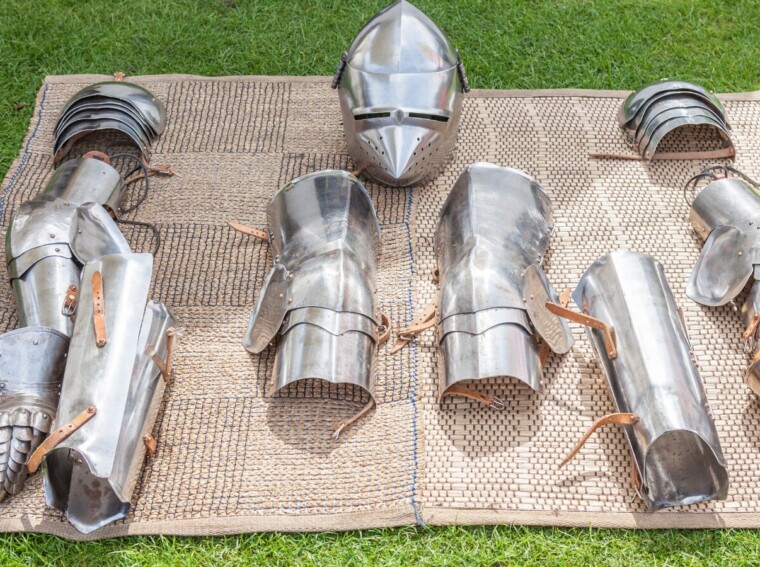The knight staggered while pinned against a wooden rail and pummeled with axes. Two completely armored attackers tried to throw him off balance by kicking his legs. A sword flickered momentarily and the shocked assailants found themselves under the 280 pounds of man, plus metal, already down and making a racket like a huge piece of metal falling. Buhurt armour resembles a human demolition derby in which both men and women, armored to the extent of 100 pounds, fight with steel swords and axes until one is the last to fall, or lose points.
The Brutal Demands of Buhurt Combat
Buhurt, or full-contact medieval fighting, is performed under rigorous international rules set by the Historical Medieval Battle (HMB) Federation, which decides safety, authenticity, and competition criteria for the sport. HMB rules require knights to use completely closed armors made of approved metals and replicas having the exact specifications of the 13th to 17th centuries.
To protect you, for example, the entire splinted arms set is made of robust titanium strips, with the splints glued to a wool/canvas backing for optimal comfort during use. The set features four essential elements of protection: a vambrace, elbow protection, rerebrace, and pauldron. All are intended to form a seamless layer of defense for the upper body.
The set includes:
- Vambrace (forearm protection)
- Elbow protection
- Rerebrace (biceps protection)
- Paldtron (shoulder protection)
Each entire splinted arm set is custom manufactured for each combatant, providing a flawless fit.
Sabatons are crafted using either hard spring steel or light titanium. Each option has its own benefits and drawbacks, with titanium being the lighter of the two, which is a big plus when your overall armor load is already 30 kg or more. These sabatons are tough, easy to move, and made for the best performance. This is the equipment that makes things happen.
These sabatons are tough, easy to carry, and made for performance. Do you want to sweep, stomp, or block with assurance? This is the gear that enables it. Sabatons that will fit HMB won’t be a problem anymore. Nothing needs to be connected. You get a set that is already paired, built, and designed to work together.
Materials That Withstand Impact
Armorers like Medieval Extreme have a specialization in metallurgy and materials science which helps them to find the perfect combination of weight, strength, and flexibility. The requirement for HMB and IMCF competition standards is that each piece should be able to tolerate repeated shock loading without failure while still allowing ergonomic movement and keeping the period precision (which is a requirement for HMB and IMCF).
The modern world of armorers is filled with power tools and precision machining but the organizational structure and the quality of the work still remind of the medieval times. The making of steel sheets starting from solid blocks was the primary method. These blocks would be water-power hammered to produce and then early metal rollers would make them into plates. Cold and hot forging processes were used to make components like greaves, spaulders, and helmets; the working of them was done on steel form anvils.
Observe today’s specifications:
- The majority of the Medieval Extreme armor sets are built with a central structure that consists of heat-treated high-carbon and spring steels which enhances their tensile strength, elasticity, and impact absorption during full contact battles.
- The use of titanium and high-quality toughened aluminum alloys makes it possible to have lighter armor without compromising the necessary defensive integrity for high mobility.
- The multi-layer integrated cushioning system that incorporates closed-cell foams and viscoelastic inserts, is designed to spread the shock over a longer period of time during encounters.
What is produced as a result of all this is a combination of historical authenticity and modern technology: armor that is in line with its medieval past but at the same time is capable of meeting the very tough conditions of today’s full-contact battle.
Inside the Design Room — Building the Perfect Armour
At Medieval Extreme, every construction work starts with exact measurement and personal fit, which are the very foundation of combat-ready performance. Each commission is done starting from the human size. The client comes dressed in the gambeson that he/she wants to wear in the battle, which acts as the size reference for the entire set of armor. Our armorers make a record of each and every curve in bright light and the measures are tight but never uncomfortable. When a customer orders both armor and padding, we measured the bare arm but always made a note of it to guarantee the proper fit.
After forging and heat treatment are done, the plates are returned to the fitting form and the craftsmanship takes precedence over speed: we manually adjust hems, enhance sliding rivets, and line up linings until the arm harness works like one, articulated system.
We suggest that all fighters treat their boots with a soft brush after every training session, apply leather conditioner regularly to avoid cracks, and avoid keeping the leather in areas of high moisture or direct heat. Care maintains armor, padding, and movement mechanics while providing comfort and fit.
When Tradition Meets Engineering
New-age buhurt armor combines centuries of skills with modern material technology. Every part of the armor is a mixed bag of medieval craftsmen’s skill, strength, and creativity, which were made even better through the application of modern-day engineering standards to meet the exacting needs of full-contact fighting. Medieval Extreme keeps this tradition alive and takes it further. If you are stepping onto the list for the first time or your tournament gear is being upgraded, come over to our workshop and watch the fusion of tradition and technology. You are also welcome to take a look at all the things.
